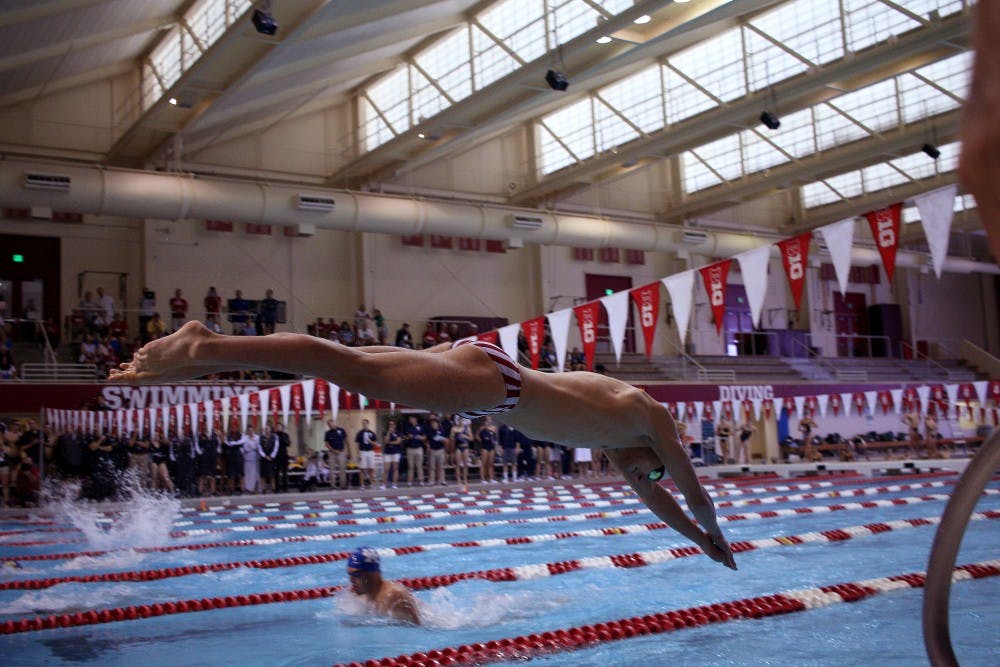Readers frequently encounter sports jargon that is completely foreign to them. Men’s swimming and diving has a multitude of events, each with their own regulations. Here is a list of some competition categories and a bit about each event.
50-yard freestyle
The 50-yard is the shortest distance of all the freestyle races, followed by distances like 100, 200, 500 and 1650 yards.
- The swimmer can use any style other than backstroke, breaststroke or butterfly. These can be used in the medley races.
- The objective is to swim as fast as possible to the end of the pool and back. The number of trips made depends on the distance.
- Aside from the first 15 meters after the start of the race, part of the swimmer’s body must be above water –not counting the underwater turn after touching the end wall.

100- and 200-yard backstroke
This is the only race where the swimmer begins in the water.
- The swimmer is on his or her back with his arms stretched and legs extending backward. The arms are doing most of the work.
- Turning back around and timing the turn is arguably the most difficult part of this event. The swimmer must turn under the water, touch the wall and resume the backstroke to the other end of the pool.

100- and 200-yard breaststroke
The breaststroke is how most people first learn how to swim and is the slowest of the four official styles.
- There are three primary arm motions – insweep, outsweep and recovery – and two leg movements – whip and frog kick.
- As in other events, competitors in this category must turn under the water and touch both ends of the pool.

100- and 200-yard butterfly
This style originated from the breaststroke and is the newest of the four primary categories.
- The swimmer can be fully underwater for 15 meters before bringing their head to the surface.
- Swimmers remain on their chests while maintaining synchronized push and pull movements with both their arms and legs. Breathing is difficult and timing for getting air is crucial in this event.

200- and 400-yard medley relay
A medley is a combination of the four competition styles in order (backstroke, breaststroke, butterfly and freestyle). An individual swimmer completes just one of these categories while three others from the same team complete the others.
- Teammates complete their turns by touching the wall, which enables the next swimmer to begin.
- In order to achieve a quicker time, it is crucial for the upcoming swimmer to accurately time when their teammate touches the pool wall.
200- and 400-yard individual medley
Regulations for the individual medley are nearly the same as those for the regular one.
- Rather than beginning with the backstroke, the swimmer starts with the butterfly and proceeds with the backstroke, breaststroke and freestyle.
- To transition from one category to the next, the swimmer must leave the wall on his back to start the backstroke, leave the wall on his chest for the breaststroke and touch the wall on his breast to start the freestyle.
200-, 400- and 800-yard freestyle relay
A teammate can only enter the water once the swimmer before them touches the wall.
Diving events: To preface this section, it is important to note that much more can be said about these events and competitive diving in general. Like each of the styles for the swimming competitions, diving has its own unique mechanisms that could take ages to explain.
1- or 3-meter and platform diving
Forward: The body is positioned forward and the dive is performed forward.
Reverse: The diver is positioned backward and their body rotates back to the board.
Backward: The diver has their back to the water and rotates away from the board.
Inward: The diver has their back to the water and rotates toward the board.
Twist: This dive incorporates a variety of movements from the above dives.
Armstand: This type of dive is only for the platform category. The diver begins in a handstand position.

Dive Positions: free, pike, tuck and straight.
Free: This is only performed on twisting dives and includes a combination of tuck or pike and straight.
Pike: The diver’s legs are straight and the body is bent at the waist.


Tuck: The diver’s body is bent at the knees and hips. Their knees are held and close to the chest, while their heels are close to the buttocks.


Straight: The diver’s body is kept straight for the dive.
Divers are held to specific requirements and must perform dives like twists and somersaults.
Point Scoring: Points are awarded by multiple judges based on three categories – takeoff, flight and entry. Flight is the dive itself and entry is how big of a splash is made.
The diver’s total is then calculated based on how difficult the dive was.
Difficulty is assessed considering factors like the height of the platform and the type of moves utilized.




